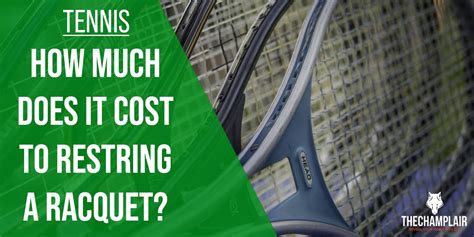Tennis Racquet Restringing Cost Calculator: A Comprehensive Guide
Restringing your tennis racquet is crucial for maintaining optimal performance and preventing injuries. However, the cost can vary significantly depending on several factors. This guide will help you understand the variables influencing the price and how to use a (theoretical) tennis racquet restringing cost calculator to estimate the expense. While there isn't a universally available online calculator for this specific purpose, we'll break down the elements so you can easily calculate the cost yourself.
What Factors Influence Tennis Racquet Restringing Costs?
Several factors contribute to the final price of restringing your tennis racquet. Understanding these will allow you to accurately predict the expense and make informed decisions.
1. Type of String:
This is arguably the biggest factor influencing the cost. Strings vary greatly in price, ranging from budget-friendly synthetic gut to high-performance natural gut.
- Synthetic Gut: The most affordable option, offering a good balance between durability and feel.
- Polyester: Known for its durability and power, often preferred by aggressive players. Different polyester strings offer varying levels of stiffness and feel.
- Natural Gut: The most expensive option, providing exceptional feel, comfort, and power. It's more prone to breaking than synthetics.
- Hybrid Strings: Combining different types of strings (e.g., natural gut in the mains and polyester in the crosses) offers a customized playing experience. This usually increases the cost.
2. String Tension:
Higher tension generally leads to a firmer, more powerful shot but can also be harsher on the arm. Lower tension provides more comfort and control but may result in a less powerful shot. The labor involved in achieving the desired tension doesn't significantly affect the cost, but your personal preference in string tension may influence the type of string you choose (and its cost).
3. Racquet Type and Size:
While not a major cost driver, the size and type of racquet can slightly influence the time taken for restringing. Larger racquets might take slightly longer, although the difference is usually negligible in the overall cost.
4. Labor Costs:
The hourly rate charged by the stringer is another key factor. This can vary based on location (urban areas often have higher labor costs), the stringer's experience, and the demand in their area.
5. Additional Services:
Some stringers offer additional services, such as grip replacement, racquet cleaning, or even minor racquet repairs. These add-ons will increase the total cost.
How to Create Your Own Tennis Racquet Restringing Cost Estimate
While a dedicated online calculator may not exist, you can easily calculate your estimated cost by following these steps:
-
Determine the String Cost: Check the price of your preferred string type per set (usually 1 set is enough for a single racquet). This information is usually readily available from online retailers or your local sporting goods store.
-
Estimate Labor Costs: Find out the labor cost from your local stringer. Many stringers will list this information on their website or you can call them directly. If they don't list a price, try calling a few different stringers to get a range of costs.
-
Add the Costs Together: Simply add the cost of the string and the labor cost. This provides a reasonable estimate for your total restringing cost.
-
Account for Additional Services: Include the cost of any additional services (grip replacement, etc.) your stringer offers.
Frequently Asked Questions (FAQs)
How often should I restring my tennis racquet?
The frequency of restringing depends on how often you play, your playing style, and the type of string used. Generally, it's recommended to restring every 4-6 weeks of regular play, or whenever you notice a significant loss of power or control.
Can I restring my tennis racquet myself?
While it's possible to restring a racquet at home, it requires specialized tools and considerable skill. It's generally recommended to take your racquet to a professional stringer to ensure it's done correctly, preserving the integrity of your racquet and maximizing your performance.
What is the average cost of tennis racquet restringing?
The average cost can range widely, from $20 for a budget-friendly restringing to $50 or more for higher-end strings and labor. Factors such as string type, labor costs, and additional services greatly influence the final price.
How long does it take to restring a tennis racquet?
Most professional stringers can complete a restringing job within 1-2 hours, but this can depend on their workload and the complexity of the job.
By understanding these factors and following the simple estimation steps above, you can easily determine the likely cost of restringing your tennis racquet. Remember to factor in potential variations based on your location and the services available at your local stringer.

